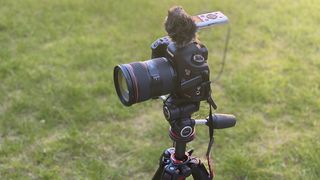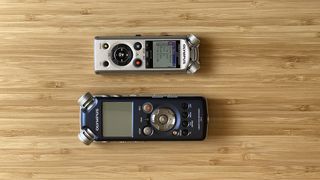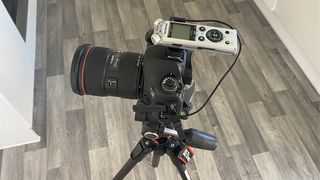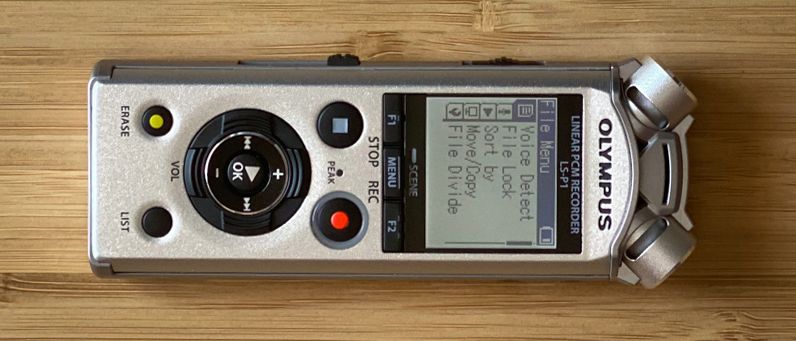Digital Camera World Verdict
The Olympus LS-P1’s dinky dimensions and low weight belie the power housed inside: the ability to record at above-CD quality, the easy-to-use Zoom microphone feature, and a selection of controls to tease out the best from audio recordings. The unit sits snugly on the camera and is so light you won’t even notice it’s there. Performance is good, supported by a logical control layout and some intelligent features, including battery recharging via the built-in USB connector – no cable required. And the Videographer Kit’s supplied accessories mean that with camera ready, you are all set to go out of the box.
Pros
- +
High quality 96kHz 24-bit recordings
- +
Tidy control layout
- +
4GB internal flash storage
- +
Up to 32GB microSDHC external storage
Cons
- -
Nothing at this price point
Why you can trust Digital Camera World
The Olympus LS-P1 is a super small audio recorder that's designed to capture clear and crisp sound. We put it to the test to see just how well it performs – and whether videographers, filmmakers and vloggers should invest in this audio recorder.
Olympus is very well known for its photographic kit, of course, but amongst other product lines it also produces a range of well-regarded audio recorders. These will typically crop up in the hands of musicians, sound recordists – and journalists – as well as film-makers. However, it’s the latter group that Olympus is targeting with two new audio recorder bundles optimized for the needs of both vloggers and videographers.
• Read more: Best microphone for vlogging
Two kits are available: each one based around an LS-P1 or LS-P4 linear PCM recorder and application-specific accessories. The LS-P1 Videographer Kit (on test here), comes with a 29cm (11.5in) stereo audio cable with 3.5mm TRS jacks for attaching the recorder to a camera, plus a windshield and a hot shoe adapter.
While the more expensive LS-P4 features the same accessory set, the hardware also supports FLAC recording and playback (for lossless file compression), while firmware update version 1.10 adds a Slate Tone function for easier sound file editing.

Specifications
Billed by Olympus as the most compact high-resolution audio recorders in their class, the LS-P1 and LS-P4 both record at a higher quality than CDs (44.1kHz), saving the files to 4GB of internal flash memory, or to microSD cards with capacities of up to 32GB (an 8GB card is included in both kits).
Both the LS-P1 and LS-P4 offer a professional-level sampling rate of up to 96kHz/24-bit, in linear PCM WAV format. MP3 recording is also an option on both recorders (with, as mentioned, the addition of the FLAC format on the LS-P4).
As a long-term user of the (now discontinued) Olympus LS-5 linear PCM recorder, shoehorning in all this under-the-hood capability into a smaller form factor is some achievement by Olympus: the LS-P1 is positively dinky – just 10.89cm tall by 3.96cm wide, with a weight of 0.75kg – making it ideal for hot-shoe mounting on today’s ultra-video-capable compact mirrorless cameras, as well as bigger and chunkier rigs.

Key features
The LS-P1 has 90º directional microphones and a Zoom mode offers targeted focus on the desired sound being recorded. (The feature is enabled via the menu system using a graphic not unlike the angle of view diagram familiar to photographers. If recording a static subject speaking, you’d favour a setting of +6; to capture as much ambient noise as possible, you’d go for -3.)
Other features on the LS-P1 include a choice of five recording levels, including Automatic and Manual, a low-cut filter for removing background noise, and a limiter for use when setting the recording level manually, and which can be optimised for either voices or music.
Vloggers or videographers can attach the LS-P1 to their camera hot shoes via the included adapter. A screw thread adapter facilitates connection to the rear of the unit; the other end slides into the hot shoe and is tightened via a screw clamp.
Connecting the audio cable allows the audio to be recorded via the camera, and monitored accordingly.
Arranging files on the device is effected via the Menu button; this calls up a choice of five locations to save recordings: Folder A, B, C, D and E, plus a dedicated Music folder – which all correspond to the subfolder structure that’s displayed when attaching the LS-P1 to a computer.
Different folders can be used to store different types of recording; storing files in the Music folder means you can use the LS-P1 as a handy portable music player if required.
But if you can’t remember where you left an important recording, then the Calendar Search function – the second choice on the Home screen, accessed via the F1 button – means you won’t be without it for long, as recordings are displayed according to the time created.
Downloading sound files is a breeze. A built-in Type A USB connector slides out of the body for docking with a computer and charging the battery, so unlike some previous models in the LS product line, you’ll never have to root around in your bag for that pesky cable you can’t find.
(We’ve omitted covering a range of other features on the LS-P1 that will be more relevant to other types of user – people recording meetings, lectures and conferences, for example, who will often perform basic editing and file management on the device.)
Build and handling
A compact unit, the LS-P1 fits well in the hand and is very light. Despite its featherweight payload, the device is well made and doesn’t feel particularly fragile – but the Olympus CS150 Multipurpose Case will be a good investment for anyone prone to dropping things.
The unit’s smaller dimensions call for an economical control layout. Small Menu and Function buttons line the bottom of the LCD display, and the volume controls are integrated into the circular controller under the prominent Stop and Rec buttons. A familiar feature in the LS product line, this will reassure anyone upgrading from a previous model.

Performance
We tested the LS-P1 with a mixture of speech and music sound sources, and found that selecting a Manual recording level and using the Limiter gave the best results. Automatic recording resulted in some clipping and distortion when recording music.
Used as a shotgun mic on the camera hot shoe, the LS-P1 works well. The microphones sit above the front of the camera body, rather than above the lens, so won’t be too close to the speaker when used handheld for vlogging.
Users can choose a couple of different ways to work with the recorder. Video footage and audio can be recorded separately, using a clap at the beginning of takes to sync the audio and video in the post-production software’s timeline.
Alternatively, the recorder can be connected to the camera via the supplied audio lead: just take a feed from the LS-P1’s headphone output into the camera’s microphone input, ensuring that you’ve set the output volume at a sufficient level for the camera’s audio input. Testing this with a Canon DSLR, we found that an output level of 25 (30 max) gave decent results.
Regarding recording settings, it’s best to utilise the unit’s full capabilities and choose uncompressed PCM WAV files over the MP3 format for optimum sound quality, and experiment with the microphone’s Zoom function to get the results you want.
Filming a subject sitting approximately 3.5 feet (0.9m) from the lens, the Zoom function set to maximum was useful in bridging the gap between recorder and speaker. A lavalier mic would be much closer to the speaker, of course, but would also be far more sensitive to rustling clothes or coughing.
Using the Zoom setting as wide as it would go made an indoor recording sound like it was being recorded outside, as the increased sonic spectrum picked up extraneous noises.
Playing back the footage on a computer afterwards, the LS-P1’s Auto levels had produced no clipping of speech recorded into the camera at an output volume of 25, with the sound tickling the 0db level. (For comparison, using the camera’s built-in mic – never an ideal option – the signal peaked at -10db.)
Verdict
The Olympus LS-P1 is a lightweight and compact audio recorder, but don't let its size fool you. Its ability to record at above-CD quality, the simple-to-use Zoom microphone feature and the controls available to hone audio recordings help make this a fantastic piece of kit.
If you've been looking for a high quality audio recorder that's so small that you'll barely notice it sat on top of your camera, then the Olympus LS-P1 might just be the microphone for you.
Read more
Best pro video accessories in 2020
Best camera for video in 2020: how to choose the best camera for filming
Best cameras for vlogging in 2020: for videography, vloggers & content creators

Niall is the editor of Digital Camera Magazine, and has been shooting on interchangeable lens cameras for over 20 years, and on various point-and-shoot models for years before that.
Working alongside professional photographers for many years as a jobbing journalist gave Niall the curiosity to also start working on the other side of the lens. These days his favored shooting subjects include wildlife, travel and street photography, and he also enjoys dabbling with studio still life.
On the site you will see him writing photographer profiles, asking questions for Q&As and interviews, reporting on the latest and most noteworthy photography competitions, and sharing his knowledge on website building.

